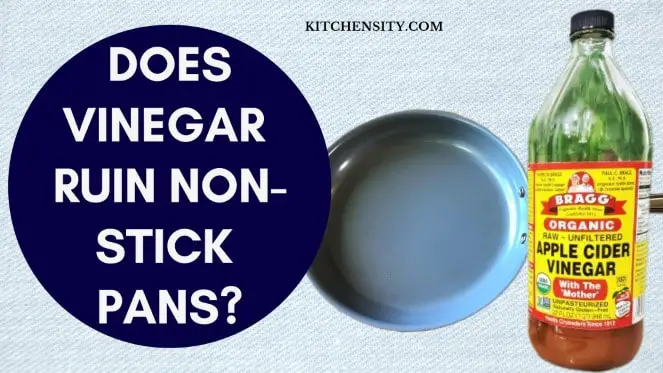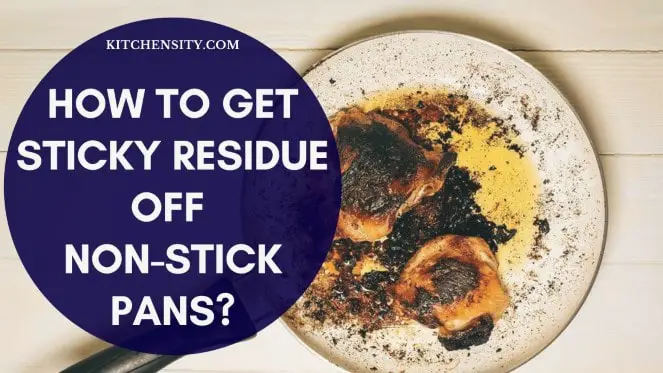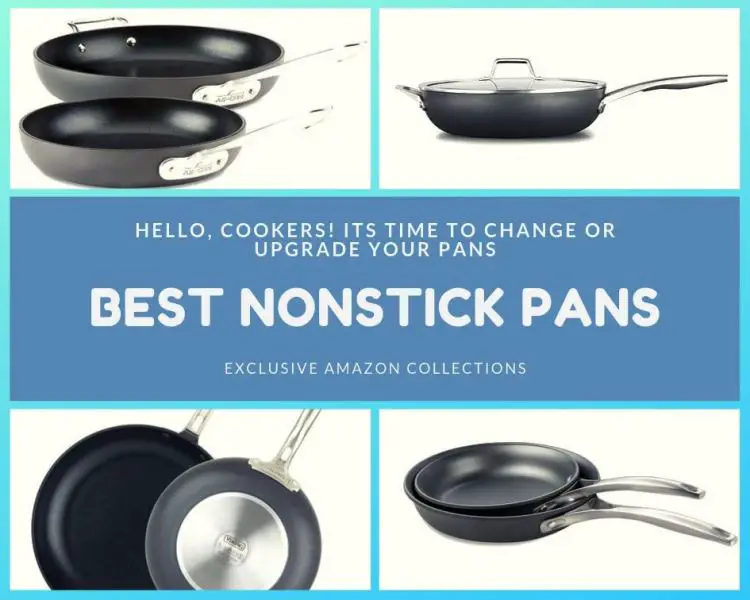In today’s environmentally conscious world, the choices we make in our kitchens can significantly impact sustainability. Non-stick cookware, known for its convenience, has come under scrutiny for its environmental footprint and potential health implications. This article explores the intersection of non-stick cookware and sustainable living, shedding light on its environmental impact, health considerations, recycling challenges, and the quest for more sustainable alternatives.
By understanding the complexities of non-stick cookware and its role in sustainable living, we can make informed choices that align with our values and contribute to a healthier planet.
Table of Contents
- 1 Non-Stick Coating Technologies
- 2 Environmental Footprint Of Non-Stick Cookware Production
- 3 Health Considerations Of Non-Stick Coatings
- 4 Recycling Challenges of Non-Stick Cookware
- 5 Sustainable Practices For Non-Stick Cookware
- 6 Non-Stick Cookware And Sustainable Living Brands
- 7 Alternative Materials For Non-Stick Cookware
- 8 Consumer Awareness: Promoting Sustainable Living Through Purchasing
- 9 Regulations And Standards For Non-Stick Cookware
- 10 Industry Innovations: Reducing Environmental Impact
- 11 Future Trends In Sustainable Non-Stick Cookware
- 12 Final Thoughts: Non-Stick Cookware And Sustainable Living
- 13 Frequently Asked Questions (FAQs)
Non-Stick Coating Technologies
Non-stick cookware relies on various coating technologies to provide its signature convenience. These coatings can be broadly categorized based on their composition and environmental impact.
- Traditional PTFE-Based Coatings: Polytetrafluoroethylene (PTFE) coatings, often marketed under the brand name Teflon, have been widely used in non-stick cookware. While effective, concerns have been raised about their environmental persistence and potential health risks associated with certain chemicals used in their production.
- Ceramic Coatings: Ceramic-based non-stick coatings are gaining popularity as more environmentally friendly alternatives to PTFE. These coatings are often promoted as free from PFOA and PTFE, addressing some of the health and environmental concerns associated with traditional non-stick coatings.
- Diamond-Infused Coatings: Some non-stick coatings incorporate diamond particles for enhanced durability and non-stick properties. While these coatings may offer improved scratch resistance and longevity, their environmental impact and sustainability credentials require further examination.
- Hybrid Coatings: Hybrid non-stick coatings combine different materials to achieve specific performance characteristics. These coatings may offer a balance between non-stick properties and environmental considerations, but their overall impact depends on the specific composition.
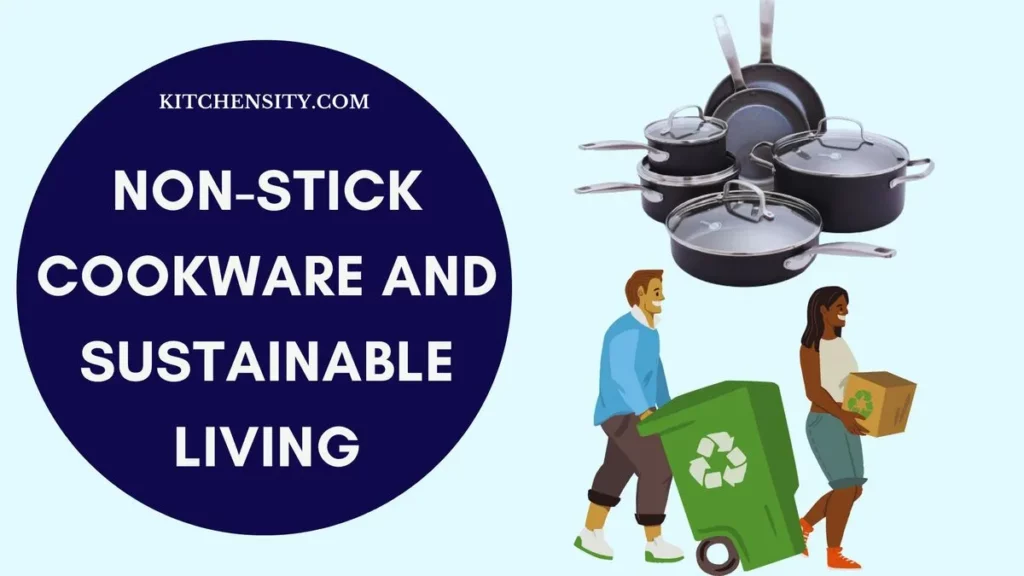
Also Read – Types Of Non-Stick Coatings
Comparison Of Non-Stick Coatings Environmental Impact
When comparing the environmental impact of these coatings, factors such as raw material sourcing, manufacturing processes, durability, and end-of-life disposal need to be considered. While ceramic and other alternative coatings are marketed as more environmentally friendly, their overall impact depends on a range of factors and may vary between products and manufacturers.
Comparison of Environmental Impact of Non-Stick Coating Technologies:
| Aspect | PTFE-Based Coatings | Ceramic Coatings | Diamond-Infused Coatings | Hybrid Coatings |
| Raw Material Sourcing | Derived from petrochemicals, which can have environmental implications due to extraction processes and non-renewable nature. | Often based on natural minerals and water-based solutions, offering a potential advantage in terms of sustainability and environmental impact. | May require specific mining processes for diamond particles, which can raise concerns about environmental impact and ethical sourcing. | Depends on the specific composition, but may incorporate both traditional and alternative materials, requiring a careful assessment of their environmental impact. |
| Manufacturing Processes | Typically involves high-temperature processes and chemical treatments, which can contribute to greenhouse gas emissions and waste generation. | Generally involves lower-temperature processes and may use fewer chemicals, potentially reducing energy consumption and environmental impact. | May require specialized manufacturing techniques, which can be energy-intensive and may involve the use of additional resources. | Varies widely based on the specific materials used and the manufacturing processes involved. |
| End-of-Life Disposal | Can be challenging to recycle due to the difficulty of separating PTFE from the metal substrate, leading to potential waste generation and environmental impact. | Generally considered more recyclable than PTFE-based coatings, offering the potential for reduced waste and environmental impact at end-of-life. | Recycling challenges similar to PTFE-based coatings, as the diamond particles may be difficult to recover and reuse, potentially leading to waste generation. | Recycling potential depends on the specific materials used, with some hybrid coatings offering improved recyclability compared to traditional PTFE-based coatings. |
| Longevity and Durability | Known for their durability and longevity, which can reduce the frequency of replacement and overall environmental impact. | Can vary depending on the specific formulation, but some ceramic coatings are known for their durability and resistance to wear. | Diamond-infused coatings may offer enhanced durability, potentially extending the lifespan of the cookware and reducing the need for replacements. | Varies based on the specific materials and manufacturing processes, with some hybrid coatings offering improved durability compared to traditional PTFE-based coatings. |
Also Read – Environmental Impact Of Non-Stick Cookware
Environmental Footprint Of Non-Stick Cookware Production
The production of non-stick cookware can have a significant environmental footprint, encompassing various stages from raw material extraction to manufacturing processes. One of the primary concerns is the use of perfluorooctanoic acid (PFOA) and other perfluorinated chemicals (PFAS) in the production of traditional PTFE-based coatings. These chemicals are persistent in the environment and can pose health risks, prompting regulatory restrictions and a shift towards more eco-friendly alternatives.
The extraction and processing of raw materials for non-stick coatings, particularly those derived from petrochemicals, can contribute to greenhouse gas emissions and other environmental impacts associated with fossil fuel extraction. Also, the high-temperature processes involved in coating application and curing can consume significant amounts of energy, further adding to the environmental footprint.
Waste generation is another concern, as the production of non-stick coatings and cookware can result in by-products and waste materials that require proper disposal or treatment. This includes the disposal of unused or excess coating materials, as well as the management of wastewater and emissions from manufacturing facilities.
Also, the transportation of raw materials and finished products can contribute to the overall environmental impact, especially if long-distance shipping is involved. This aspect of the environmental footprint is influenced by factors such as sourcing practices, manufacturing locations, and distribution networks.
So, the environmental footprint of non-stick cookware production is multifaceted, involving considerations related to raw material extraction, manufacturing processes, waste management, and transportation. Efforts to reduce this footprint include the development of alternative coatings with lower environmental impact, improved manufacturing practices, and a focus on energy efficiency throughout the production.
Also Read – Best Non-Stick Cookware Brands
Are Non-Stick Pans Good For The Environment?
Non-stick pans have both positive and negative environmental aspects. While they can reduce the need for excessive oil use during cooking, their production involves potentially harmful chemicals and high-energy processes. Also, their disposal and recycling pose challenges due to the complexity of their materials. While non-stick pans offer convenience in cooking, their environmental impact depends on factors like their manufacturing processes, coatings, and end-of-life management.
Health Considerations Of Non-Stick Coatings
Non-stick coatings, especially those containing polytetrafluoroethylene (PTFE), have raised concerns about potential health risks. When heated to high temperatures, PTFE coatings can release fumes that contain perfluorooctanoic acid (PFOA) and other harmful compounds.
Inhaling these fumes, often referred to as “Teflon flu,” can cause flu-like symptoms such as headache, fever, and chills. While these symptoms are temporary and typically resolve on their own, long-term exposure to PFOA has been linked to more serious health issues, including cancer and developmental problems.
To minimize health risks, it’s important to use non-stick cookware responsibly, avoiding overheating and using ventilation when cooking at high temperatures. Also, choosing cookware with alternative coatings, such as ceramic or silicone-based coatings, can reduce the potential for harmful fume release.
While modern non-stick coatings are designed to be safe under normal cooking conditions, it’s essential to be aware of the risks associated with overheating and take precautions to ensure safe usage.
Also Read – Do Chefs Use Non-Stick Cookware?
Recycling Challenges of Non-Stick Cookware
Recycling non-stick cookware presents several challenges due to the complex nature of its construction. Non-stick pans typically consist of a metal base coated with a non-stick material, such as polytetrafluoroethylene (PTFE), which can be difficult to separate during the recycling process.
The high temperatures required to melt and separate the metal from the non-stick coating can pose challenges, as the non-stick coating may release potentially harmful fumes when heated to such extremes. This complicates the recycling process and requires specialized equipment and facilities to ensure safe handling.
Also, the presence of PFOA and other perfluorinated compounds in some non-stick coatings raises environmental and health concerns during recycling. Proper disposal of any residual materials is crucial to prevent environmental contamination and health risks.
Due to these challenges, many recycling facilities may not accept non-stick cookware, leading to a lack of viable recycling options for consumers. As a result, non-stick cookware often ends up in landfills, contributing to environmental waste.
Efforts to address these challenges include the development of new recycling technologies and processes that can safely and efficiently separate the non-stick coating from the metal base. Also, promoting the use of alternative, more recyclable materials for non-stick coatings could reduce the environmental impact of non-stick cookware at the end of its life cycle.
Also Read – What Recipes Work Best With Non-Stick Pans?
Sustainable Practices For Non-Stick Cookware
To sustainably use and care for non-stick cookware, avoid high heat, use gentle cleaning methods with soft utensils, store the cookware properly, regularly inspect for damage, and dispose of it responsibly when necessary. These practices can extend the life of the cookware and minimize its environmental impact.
- Avoid High Heat: Non-stick coatings can degrade at high temperatures, releasing potentially harmful fumes. Use low to medium heat settings to prolong the life of your cookware and reduce the risk of fume release.
- Gentle Cleaning: Use soft sponges or cloths for cleaning to avoid scratching the non-stick coating. Harsh abrasives can damage the coating, reducing its effectiveness and lifespan.
- Avoid Metal Utensils: Use wooden or silicone utensils to avoid scratching the non-stick surface. Scratches can lead to food sticking and reduce the performance of the cookware.
- Proper Storage: Store non-stick cookware carefully to prevent damage. Avoid stacking pans inside each other, as this can lead to scratches and chips in the coating.
- Regular Inspection: Periodically check your non-stick cookware for signs of wear or damage. If you notice any chips or scratches in the coating, consider replacing the cookware to avoid potential health risks.
- Responsible Disposal: When it’s time to replace your non-stick cookware, dispose of it responsibly. Check with local recycling facilities to see if they accept non-stick pans or follow any specific disposal guidelines in your area.
Also Read – How To Care For Non-Stick Pans When Used Outdoors?
Non-Stick Cookware And Sustainable Living Brands
Sustainable living and healthy cooking go hand-in-hand, and choosing the right non-stick cookware is a key part of that equation. Several brands focus on producing non-stick cookware with a commitment to sustainability. They achieve this by using environmentally friendly materials, such as ceramic coatings free from PFOA and PTFE, and implementing eco-friendly production processes that minimize waste and energy consumption.
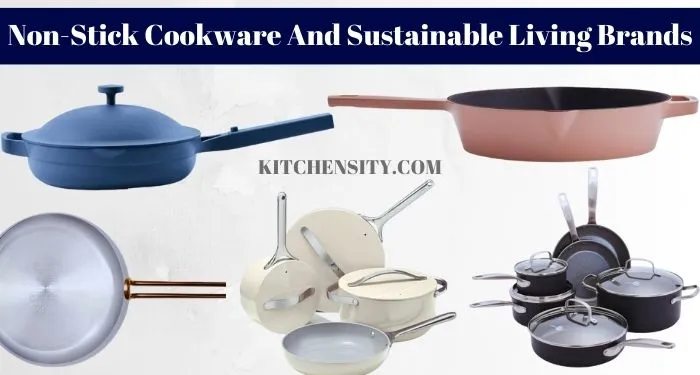
Luckily, there are many innovative brands out there creating non-stick pans that are both kind to your health and the planet. Here are a few to consider:
- GreenPan: This Belgian brand is a pioneer in healthy non-stick technology. Their Thermolon ceramic coating is derived from sand and completely free of PFOA, PFAS, and other harmful chemicals. Plus, it’s incredibly durable and scratch-resistant, even for metal utensils.
- Caraway Home: This trendy brand offers stylish and sustainable non-stick cookware sets in a variety of vibrant colors. Their ceramic coating is also PFOA-free and boasts excellent heat distribution for even cooking. Caraway also focuses on sustainability by using recycled aluminum in its pans and offering packaging made from recycled materials.
- Milo by Kana: This brand specializes in beautifully crafted enameled cast iron cookware that’s naturally non-stick thanks to its smooth porcelain enamel surface. Their pots and pans are built to last a lifetime and come in a range of elegant colors to complement any kitchen. Plus, enameled cast iron is naturally free of harmful chemicals and requires minimal oil for cooking, making it a healthy choice.
- Our Place: This direct-to-consumer brand has gained a cult following for its Always Pan, a versatile pan that can replace eight traditional cookware items. The pan features a non-toxic, ceramic nonstick coating that’s free of PFOA, PFAS, and lead. Our Place also prioritizes sustainability by using recycled aluminum and offering carbon-neutral shipping.
- Great Jones: This brand is shaking up the cookware scene with its colorful and functional Dutch ovens and sheet pans. Their non-stick coating is PFOA-free and oven-safe up to 500°F. Great Jones also uses recycled materials in their packaging and sources responsibly, making them a great choice for eco-conscious cooks.
Here is a comparison table for the above five brands of non-stick cookware:
| Feature/Pans | GreenPan | Caraway Home | Milo by Kana | Our Place | Great Jones |
| Type of non-stick coating | Thermolon ceramic (derived from sand) | Ceramic | Enameled cast iron | Ceramic | Ceramic |
| PFOA/PFAS-free? | Yes | Yes | Yes | Yes | Yes |
| Metal utensil safe? | Yes | Yes | No (enameled cast iron) | Yes | Yes |
| Oven safe temperature | Up to 600°F | Up to 550°F | Up to 500°F (enameled cast iron) | Up to 500°F | Up to 500°F |
| Induction compatible? | Yes | Yes | No (enameled cast iron) | Yes | Yes |
| Sustainability features | Recycled aluminum, recycled packaging | Recycled aluminum, recycled packaging | Durable cast iron, minimal oil needed | Recycled aluminum, carbon-neutral shipping | Recycled packaging, responsible sourcing |
| Price range | $50-$200 | $150-$350 | $200-$500 | $100-$150 | $50-$150 |
These are just a few of the many sustainable and healthy non-stick cookware brands on the market. When choosing a pan, be sure to consider your cooking needs, budget, and desired features. With so many great options available, you’re sure to find the perfect pan for your eco-friendly kitchen!
Also Read – Can You Use Non-Stick Cookware On High Heat?
Alternative Materials For Non-Stick Cookware
Traditional non-stick cookware often uses polytetrafluoroethylene (PTFE) coatings, which can raise environmental and health concerns. As a result, there’s a growing interest in alternative materials that offer non-stick properties without the drawbacks of PTFE.
- One alternative material is ceramic, which is derived from natural minerals and doesn’t contain PFOA or PTFE. Ceramic coatings are known for their non-stick properties and are considered more environmentally friendly.
- Another option is silicone-based coatings, which are free from PFOA and PTFE. Silicone coatings provide non-stick properties and are generally safe for both the environment and human health.
- Cast iron and stainless steel are also used as alternative materials for non-stick cookware. While they may not have the same non-stick properties as PTFE or ceramic coatings, they are durable and can be seasoned to create a natural non-stick surface.
These alternative materials offer consumers options that align with sustainability goals and reduce reliance on traditional non-stick coatings with potential environmental and health concerns.
Consumer Awareness: Promoting Sustainable Living Through Purchasing
Consumers play a crucial role in promoting sustainable living through their purchasing decisions, including the selection of non-stick cookware. By choosing cookware made from eco-friendly materials and produced using sustainable practices, consumers can support environmentally responsible manufacturers.
When purchasing non-stick cookware, consumers should look for products that are free from harmful chemicals like PFOA and PTFE. Also, considering the durability and recyclability of the cookware can further contribute to sustainable living practices.
By being informed about the environmental impact of non-stick cookware and making conscious choices, consumers can drive demand for more sustainable products. This, in turn, encourages manufacturers to prioritize eco-friendly materials and production methods, leading to a more sustainable marketplace for non-stick cookware.
Also Read – How To Use A Non-Stick Pan For The First Time?
Regulations And Standards For Non-Stick Cookware
Regulations and standards related to non-stick cookware are designed to ensure the safety of consumers and the environment. These regulations often focus on the use of chemicals in the production of non-stick coatings, such as perfluorooctanoic acid (PFOA) and perfluorooctane sulfonate (PFOS).
In many regions, including the United States and the European Union, there are strict regulations on the use of PFOA and PFOS in consumer products, including cookware. These regulations aim to limit the exposure of consumers and the environment to these potentially harmful chemicals.
In addition to chemical regulations, some standards govern the safety and performance of non-stick cookware. These standards may cover aspects such as durability, heat resistance, and non-stick properties, ensuring that products meet certain quality and safety requirements.
So, the regulatory landscape for non-stick cookware is aimed at protecting consumers and the environment from potential risks associated with these products. By complying with these regulations and standards, manufacturers can ensure that their products are safe, reliable, and environmentally responsible.
Also Read – Are Non-Stick Coatings Safe For Cooking?
Industry Innovations: Reducing Environmental Impact
The cookware industry is continuously innovating to reduce the environmental impact of non-stick cookware. One notable innovation is the development of alternative coatings that are free from harmful chemicals like PFOA and PTFE, addressing concerns about their persistence in the environment.
Another innovation is the use of recycled materials in the production of non-stick cookware, reducing the reliance on virgin resources and minimizing waste. By incorporating recycled materials into their products, manufacturers can lower their environmental footprint and contribute to a more circular economy.
Also, advancements in manufacturing processes have led to improved energy efficiency and reduced emissions. By optimizing production methods and adopting cleaner technologies, manufacturers can minimize their environmental impact throughout the supply chain.
Furthermore, some companies are exploring biodegradable or compostable materials for non-stick coatings, aiming to create products that have minimal impact at the end of their life cycle. These innovations align with the growing demand for sustainable products and demonstrate the industry’s commitment to environmental stewardship.
So, industry innovations in non-stick cookware are driving positive changes towards more sustainable practices, offering consumers greener options without compromising on performance or quality.
Future Trends In Sustainable Non-Stick Cookware
The future of non-stick cookware is moving towards more sustainable practices and materials. One emerging trend is the development of advanced ceramic coatings that offer improved non-stick properties without the use of PFOA or PTFE, addressing environmental and health concerns.
Another trend is the adoption of eco-friendly production methods, such as energy-efficient manufacturing processes and the use of renewable resources. These practices aim to reduce the overall environmental footprint of non-stick cookware production.
Additionally, there is a growing interest in recyclable non-stick coatings that can be easily separated from the metal substrate, facilitating the recycling process and reducing waste.
Furthermore, the incorporation of smart technologies, such as temperature-sensitive coatings that indicate when the pan is at the optimal cooking temperature, can improve energy efficiency and reduce the risk of overheating, enhancing the sustainability of non-stick cookware.
So, the future of sustainable non-stick cookware is promising, with continued advancements in materials, production methods, and technologies that prioritize environmental responsibility while meeting consumer demands for high-quality, effective cookware.
Also Read – Latest Advancements In Non-Stick Pans
Final Thoughts: Non-Stick Cookware And Sustainable Living
In conclusion, non-stick cookware has a significant environmental impact, from production to disposal. The use of PTFE and PFOA in traditional coatings raises concerns about sustainability and health.
However, emerging trends in alternative materials, eco-friendly production, and recyclable coatings offer hope for a more sustainable future. Consumers can contribute to this by making informed choices, opting for environmentally friendly cookware, and practicing responsible use and disposal.
By supporting industry innovations and advocating for sustainable practices, we can create a more environmentally conscious marketplace for non-stick cookware. Together, we can promote sustainable living and reduce the environmental footprint of our kitchen activities.
Also Read – How To Extend The Lifespan Of Non-Stick Pans?
Frequently Asked Questions (FAQs)
-
Are Non-Stick Coatings Environmentally Friendly?
Non-stick coatings can vary in their environmental impact. Some, like PTFE coatings, have raised concerns due to their use of potentially harmful chemicals. However, newer alternatives, such as ceramic coatings, are marketed as more eco-friendly.
-
Can Non-Stick Cookware Be Recycled?
Recycling non-stick cookware can be challenging due to the complexity of its materials. While some components may be recyclable, the separation of the non-stick coating from the metal substrate can pose difficulties.
-
What Are The Health Risks Associated With Non-Stick Coatings?
Overheating non-stick coatings can lead to the release of fumes that may contain harmful chemicals. While modern coatings are generally safe under normal use, proper care and use are important to minimize any potential health risks.
-
How Can I Dispose Of Non-Stick Cookware Responsibly?
Disposing of non-stick cookware responsibly involves checking local recycling facilities for their policies on accepting such items. If recycling is not an option, some facilities may accept them as regular waste, but it’s important to follow any specific guidelines for safe disposal.
-
What Should I Look For In Sustainable Non-Stick Cookware?
When choosing sustainable non-stick cookware, consider coatings that are free from PFOA, PTFE, and other harmful chemicals. Look for durable materials that are designed for longevity and recyclability, as well as brands with a commitment to eco-friendly manufacturing practices.
Katrina Smith is a seasoned expert with over 25 years of experience in all things related to cooking and the kitchen. As an avid cook and kitchen enthusiast, she is passionate about sharing her knowledge and expertise on cookware, kitchen appliances, kitchen tips, and kitchen staples.
Through her articles and reviews, Katrina aims to inspire and help others improve their cooking skills, experiment with different ingredients, and invest in quality cookware and appliances.


